An Efficient GPU Implementation of a Coupled Overland-Sewer Hydraulic Model with Pollutant Transport
Abstract
1. Introduction
2. Mathematical Model
2.1. 2D Surface Flow Model
2.2. 1D Pipe Flow Model
2.3. Water Exchange between Models
3. Test Cases
3.1. Case 1: UK Environmental Agency Case 8b
3.2. Case 2: Storm Drainage Capacity Test
3.3. Case 3: Pollutant Transport in a Mixed Environment
4. Conclusions
Author Contributions
Funding
Institutional Review Board Statement
Informed Consent Statement
Conflicts of Interest
References
- Barredo, J.I. Normalised flood losses in Europe: 1970–2006. Nat. Hazards Earth Syst. Sci. 2009, 9, 97–104. [Google Scholar] [CrossRef]
- Paoli, C. Integrated Flood Management. Guidelines and Study Cases; Technical Report; European Commission, Joint Research Centre, Institute for Environment and Sustainability, European Union: Ispra, Italy, 2015. [Google Scholar]
- Schomwandt, D.; Lucioni, N.; Andrade, M. Flooding risk maps and the representation of vulnerability in Gran La Plata, Buenos Aires. Rev. Geol. Apl. Ing. Ambiente 2016, 36, 15–28. [Google Scholar]
- Teng, J.; Jakeman, A.; Vaze, J.; Croke, B.; Dutta, D.; Kim, S. Flood inundation modelling: A review of methods, recent advances and uncertainty analysis. Environ. Model. Softw. 2017, 90, 201–216. [Google Scholar] [CrossRef]
- Etulain, J.; López, I. Urban flooding: Risk maps and territorial urban planning guidelines. Theoretical-methodological background and purposes. Estud. Del Habitat 2017, 15, 1–21. [Google Scholar]
- Guo, K.; Guan, M.; Yu, D. Urban surface water flood modelling—A comprehensive review of current models and future challenges. Hydrol. Earth Syst. Sci. 2021, 25, 2843–2860. [Google Scholar] [CrossRef]
- Zhou, Q.; Panduro, T.; Thorsen, B.; Arnbjerg-Nielsen, K. Verification of flood damage modelling using insurance data. Water Sci. Technol. 2013, 68, 425–432. [Google Scholar] [CrossRef]
- Bernet, V.; Prasuhn, V.; Weingartner, R. Surface water floods in Switzerland: What insurance claim records tell us about the damage in space and time. Nat. Hazards Earth Syst. Sci. 2017, 17, 1659–1682. [Google Scholar] [CrossRef]
- Blanksby, J.; Saul, A.; Ashley, R.; Djordjević, S.; Chen, A.; Leandro, J.; Savić, D.; Boonya-aroonnet, S.; Maksimović, C.; Prodanović, D. Integrated Urban Drainage: Setting the Context for Integrated Urban Drainage Modelling in the United Kingdom; Aquaterra World Forum on Delta and Coastal Development: Amsterdam, The Netherlands, 2007. [Google Scholar]
- Cea, L.; Garrido, M.; Puertas, J. Experimental validation of two-dimensional depth-averaged models for forecasting rainfall-runoff from precipitation data in urban areas. J. Hydrol. 2010, 382, 88–102. [Google Scholar] [CrossRef]
- Pathirana, A.; Maheng Dikman, M.; Brdjanovic, D. A Two-dimensional pollutant transport model for sewer overflow impact simulation. In Proceedings of the 12th International Conference on Urban Drainage, Porto Alegre, Brazil, 11–16 September 2011; pp. 10–15. [Google Scholar]
- Bates, P.; Horritt, M.; Fewtrell, T. A simple inertial formulation of the shallow water equations for efficient two-dimensional flood inundation modelling. J. Hydrol. 2018, 387, 33–45. [Google Scholar] [CrossRef]
- Fernández-Pato, J.; Caviedes-Voullième, D.; García-Navarro, P. Rainfall/runoff simulation with 2D full shallow water equations: Sensitivity analysis and calibration of infiltration parameters. J. Hydrol. 2016, 536, 496–513. [Google Scholar] [CrossRef]
- Xia, X.; Liang, Q.; Ming, X. A full-scale fluvial flood modelling framework based on a high-performance integrated hydrodynamic modelling system (HiPIMS). Adv. Water Resour. 2019, 132, 103392. [Google Scholar] [CrossRef]
- Sañudo, E.; Cea, L.; Puertas, J. Modelling Pluvial Flooding in Urban Areas Coupling the Models Iber and SWMM. Water 2020, 12, 2647. [Google Scholar] [CrossRef]
- Leandro, J.; Martins, R. A methodology for linking 2D overland flow models with the sewer network model SWMM 5.1 based on dynamic link libraries. Water Sci. Technol. 2010, 73, 3017–3026. [Google Scholar] [CrossRef]
- Fernández-Pato, J.; García-Navarro, P. 2D Zero-Inertia Model for Solution of Overland Flow Problems in Flexible Meshes. J. Hydrol. Eng. 2016, 21, 04016038. [Google Scholar] [CrossRef]
- Chen, W.; Huang, G.; Zhang, H. Urban stormwater inundation simulation based on SWMM and diffusive overland-flow model. Water Sci. Technol. 2017, 76, 3392–3403. [Google Scholar] [CrossRef]
- Fraga, I.; Cea, L.; Puertas, J. Validation of a 1D-2D dual drainage model under unsteady part-full and surcharged sewer conditions. Urban Water J. 2017, 14, 74–84. [Google Scholar] [CrossRef]
- Fernández-Pato, J.; Sánchez, A.; García-Navarro, P. Simulación de avenidas mediante un modelo hidráulico/hidrológico distribuido en un tramo urbano del río Ginel (Fuentes de Ebro). Ribagua 2019, 6, 49–62. [Google Scholar] [CrossRef]
- Yang, Y.; Sun, L.; Li, R.; Yin, J.; Yu, D. Linking a Storm Water Management Model to a Novel Two-Dimensional Model for Urban Pluvial Flood Modeling. Int. J. Disaster Risk Sci. 2020, 11, 508–518. [Google Scholar] [CrossRef]
- Leandro, J.; Chen, A.S.; Djordjević, S.; Savić, D.A. Comparison of 1D/1D and 1D/2D Coupled (Sewer/Surface) Hydraulic Models for Urban Flood Simulation. J. Hydraul. Eng. 2009, 135, 495–504. [Google Scholar] [CrossRef]
- Leandro, J.; Djordjević, S.; Chen, A.S.; Savić, D.A.; Stanić, M. Calibration of a 1D/1D urban flood model using 1D/2D model results in the absence of field data. Water Sci. Technol. 2011, 64, 1016–1024. [Google Scholar] [CrossRef] [PubMed]
- León, A.S.; Ghidaoui, M.S.; Schmidt, A.R.; García, M.H. Application of Godunov-type schemes to transient mixed flows. J. Hydraul. Resour. 2009, 47, 147–156. [Google Scholar] [CrossRef]
- Rossman, L. Storm Water Management Model User’s Manual Version 5.1 (EPA/600/R-14/413b); Technical Report; National Risk Management Research Laboratory, United States Environmental Protection Agency: Cincinnati, OH, USA, 2015.
- Rossman, L. Storm Water Management Model Version 5.1. Reference Manual. Volume II-Hydraulics (EPA/600/R-17/111); Technical Report; National Risk Management Research Laboratory, United States Environmental Protection Agency: Cincinnati, OH, USA, 2017.
- Fernández-Pato, J.; García-Navarro, P. Development of a New Simulation Tool Coupling a 2D Finite Volume Overland Flow Model and a Drainage Network Model. Geosciences 2018, 8, 288. [Google Scholar] [CrossRef]
- Morales-Hernández, M.; Lacasta, A.; Murillo, J.; Brufau, P.; García-Navarro, P. A Riemann coupled edge (RCE) 1D–2D finite volume inundation and solute transport model. Environ. Earth Sci. 2015, 74, 7319–7335. [Google Scholar] [CrossRef][Green Version]
- Baek, K.O.; Seo, I.W. Routing procedures for observed dispersion coefficients in two-dimensional river mixing. Adv. Water Resour. 2010, 33, 1551–1559. [Google Scholar] [CrossRef]
- Latorre, B.; Garcia-Navarro, P.; Murillo, J.; Burguete, J. Accurate and efficient simulation of transport in multidimensional flow. Int. J. Numer. Methods Fluids 2011, 65, 405–431. [Google Scholar] [CrossRef][Green Version]
- Murillo, J.; García-Navarro, P. Improved Riemann solvers for complex transport in two-dimensional unsteady shallow flow. J. Comput. Phys. 2011, 230, 7202–7239. [Google Scholar] [CrossRef]
- Morales-Hernández, M.; Murillo, J.; García-Navarro, P. Diffusion–dispersion numerical discretization for solute transport in 2D transient shallow flows. Environ. Fluid Mech. 2018, 19, 1217–1234. [Google Scholar] [CrossRef]
- Gordillo, G.; Morales-Hernández, M.; García-Navarro, P. Finite volume model for the simulation of 1D unsteady river flow and water quality based on the WASP. J. Hydroinformatics 2020, 22, 327–345. [Google Scholar] [CrossRef]
- Beg, M.N.A.; Rubinato, M.; Carvalho, R.F.; Shucksmith, J.D. CFD Modelling of the Transport of Soluble Pollutants from Sewer Networks to Surface Flows during Urban Flood Events. Water 2020, 12, 2514. [Google Scholar] [CrossRef]
- Wool, T.; Ambrose, R.; Martin, J.; Comer, E. Water Quality Analysis Simulation Program (WASP). Users Manual, Version 6; Technical Report; US Environmental Protection Agency: Washington, DC, USA, 2015.
- Lacasta, A.; Morales-Hernández, M.; Murillo, J.; García-Navarro, P. An optimized GPU implementation of a 2D free surface simulation model on unstructured meshes. Adv. Eng. Softw. 2014, 78, 1–15. [Google Scholar] [CrossRef]
- Brodtkorb, A.; Hagen, T.; Lie, K.; Natvig, J. Simulation and visualization of the Saint-Venant system using GPUs. Comput. Vis. Sci. 2010, 13, 341–353. [Google Scholar] [CrossRef][Green Version]
- Saetra, M.; Brodtkorb, A. Shallow Water Simulations on Multiple GPUs. In Proceedings of the Para 2010 Conference, Lecture Notes in Computer Science; Springer: Berlin/Heidelberg, Germany, 2012; Volume 7134, pp. 56–66. [Google Scholar]
- Vreugdenhil, C. Numerical Methods for Shallow Water Flow; Kluwer Academic Publishers: Dordrecht, The Netherlands, 1994. [Google Scholar]
- USDA. Urban Hydrology for Small Watersheds; Environment Agency Report; United States Department of Agriculture (USDA): Washington, DC, USA, 1986.
- Mishra, S.; Singh, V. Soil Conservation Service Curve Number (SCS-CN) Methodology; Kluwer Academic Publishers: Norwell, MA, USA, 2003. [Google Scholar]
- Murillo, J.; García-Navarro, P. Weak solutions for partial differential equations with source terms: Application to the shallow water equations. J. Comput. Phys. 2010, 229, 4327–4368. [Google Scholar] [CrossRef]
- Rubinato, M.; Martins, R.; Kesserwani, G.; Leandro, J.; Djordjević, S.; Shucksmith, J. Experimental calibration and validation of sewer/surface flow exchange equations in steady and unsteady flow conditions. J. Hydrol. 2017, 552, 421–432. [Google Scholar] [CrossRef]
- Néelz, S.; Pender, G. Benchmarking of 2D Hydraulic Modelling Packages; Environment Agency Report; UK Environment Agency: Bristol, UK, 2013.
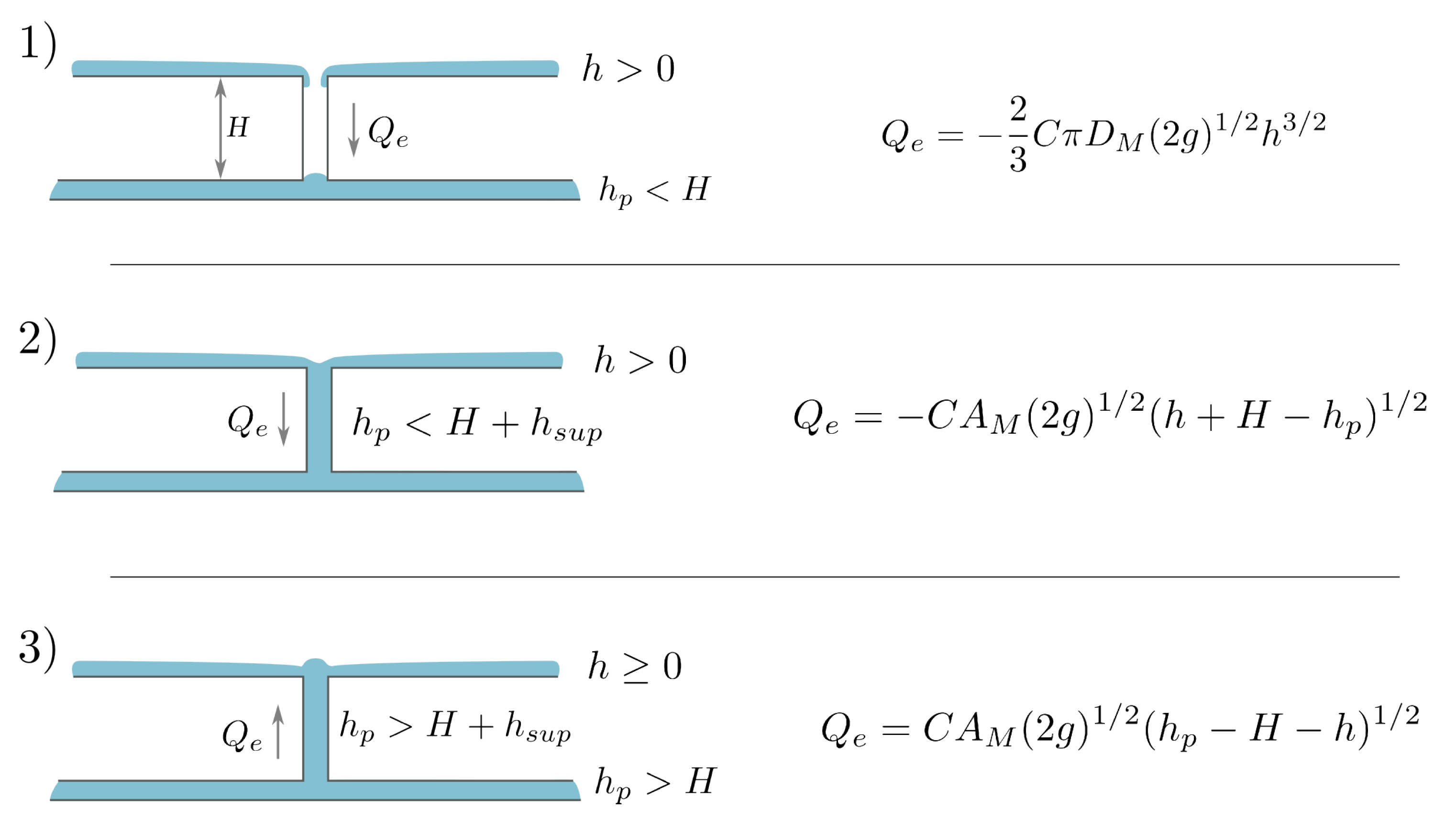
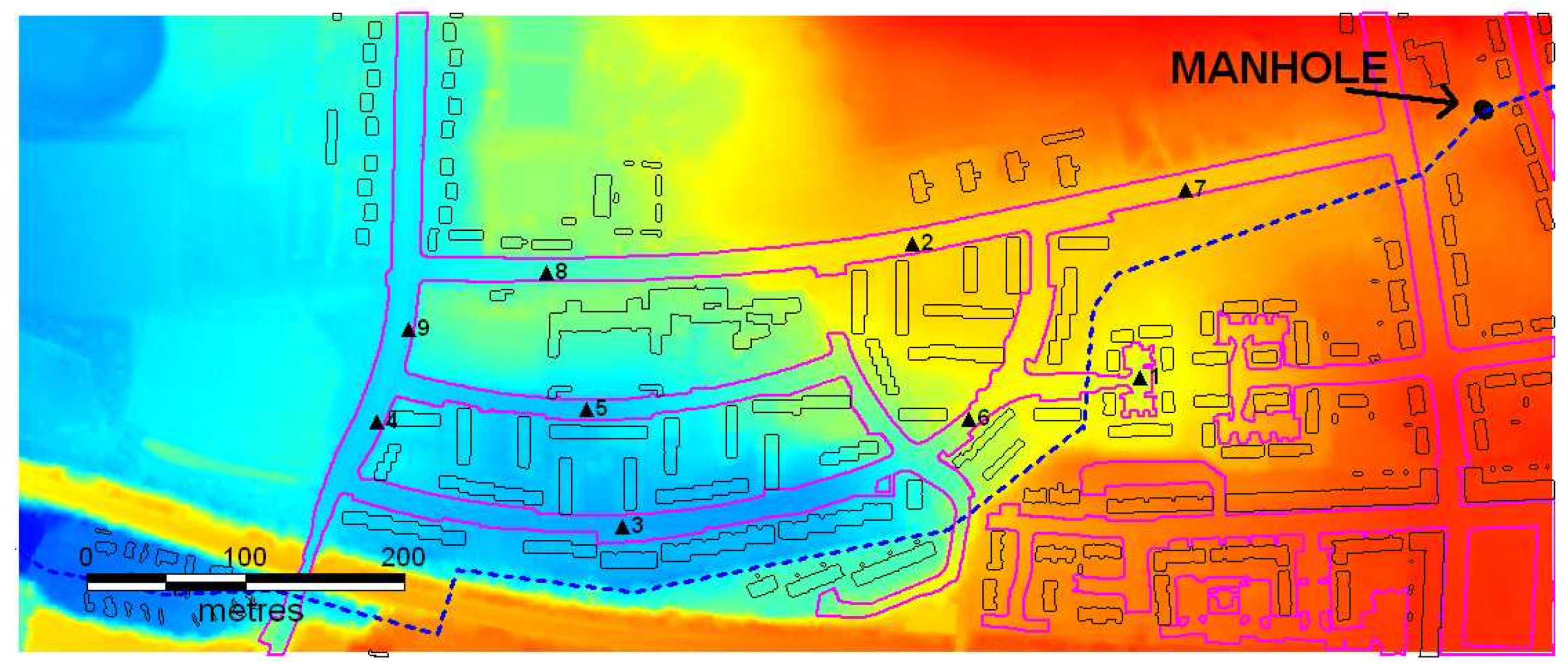

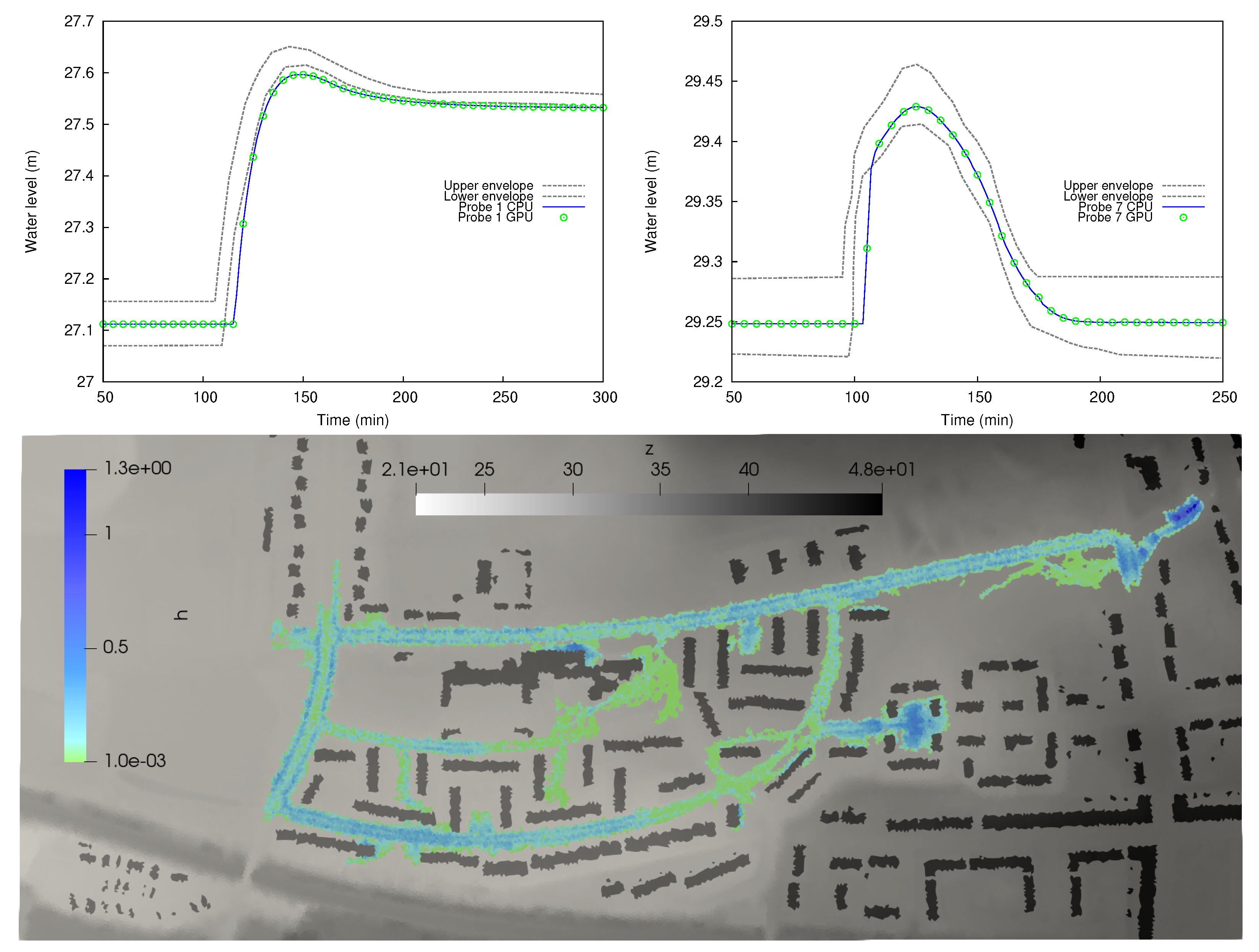
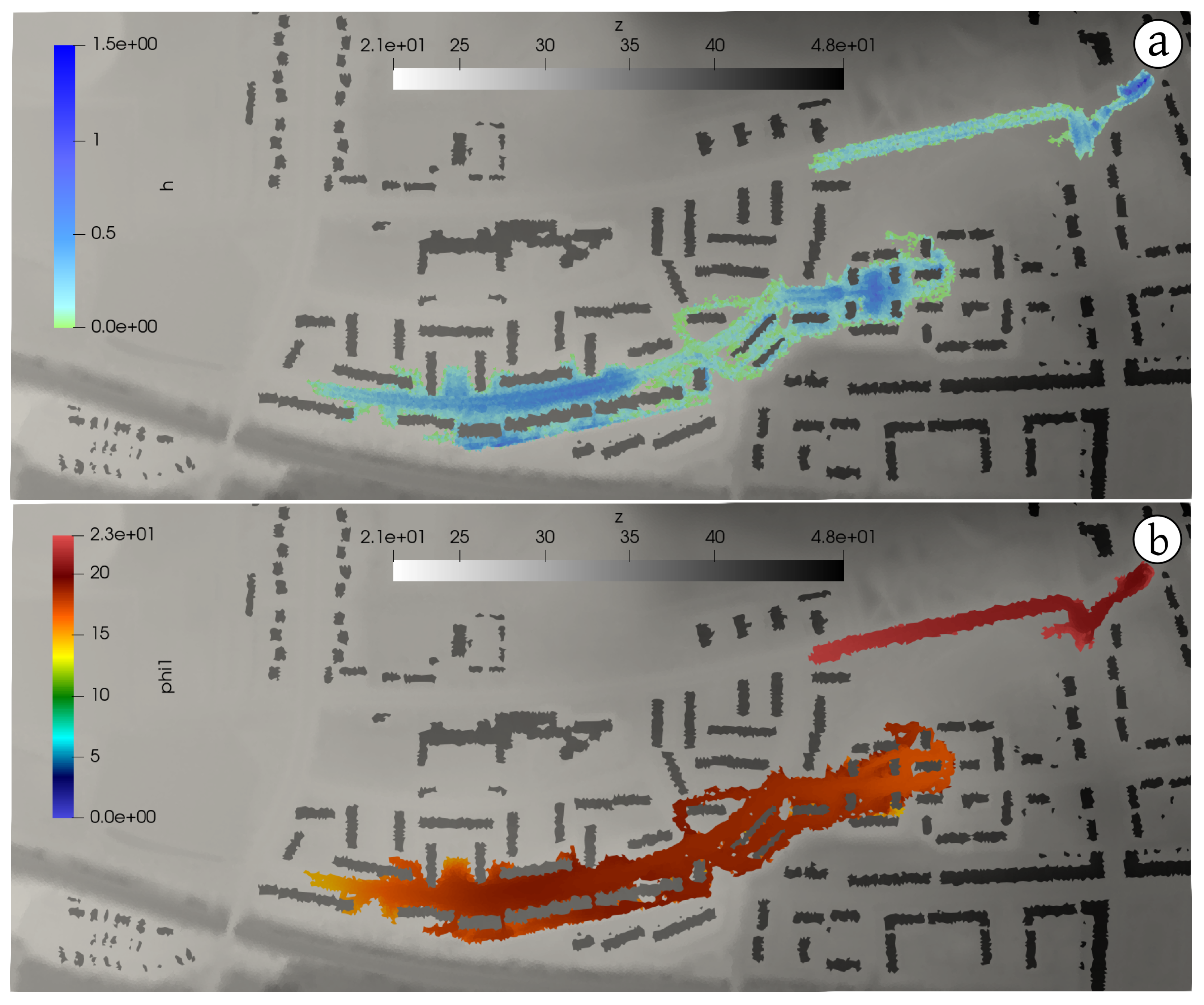
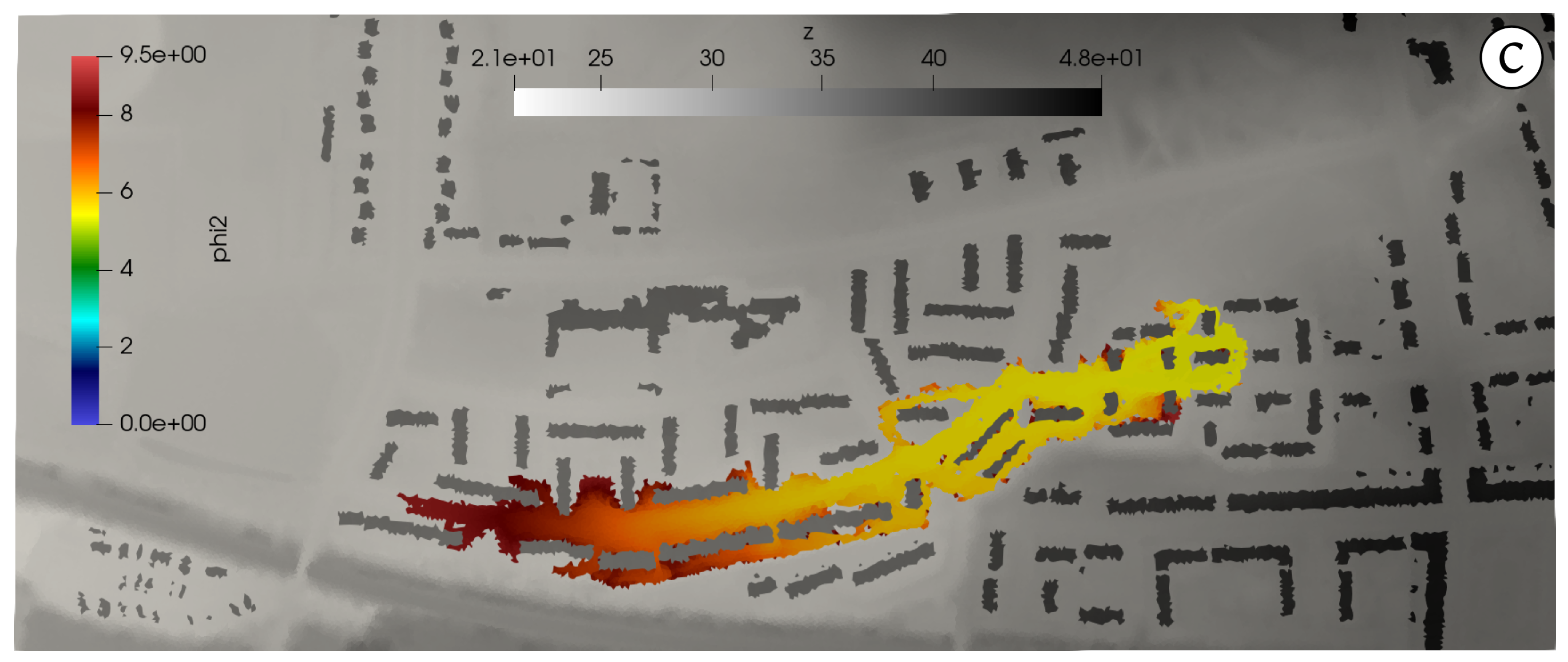

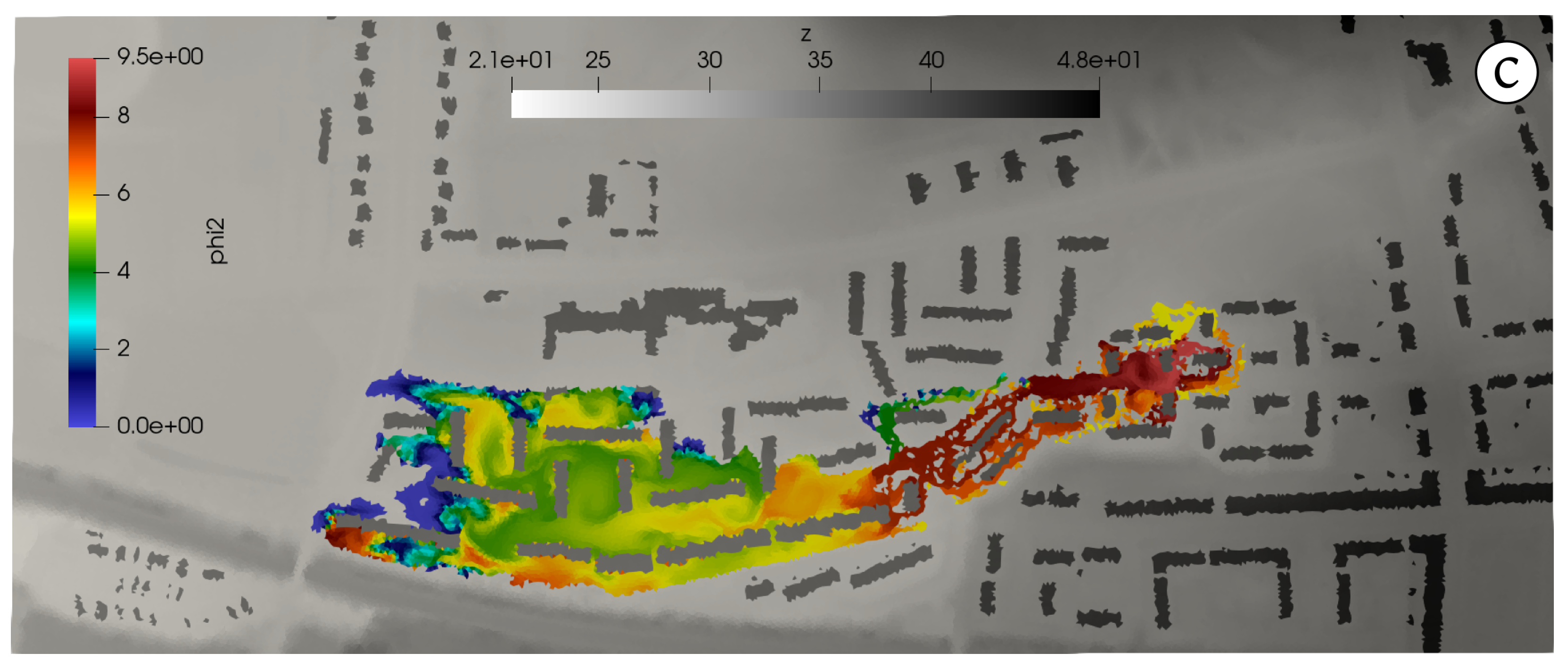
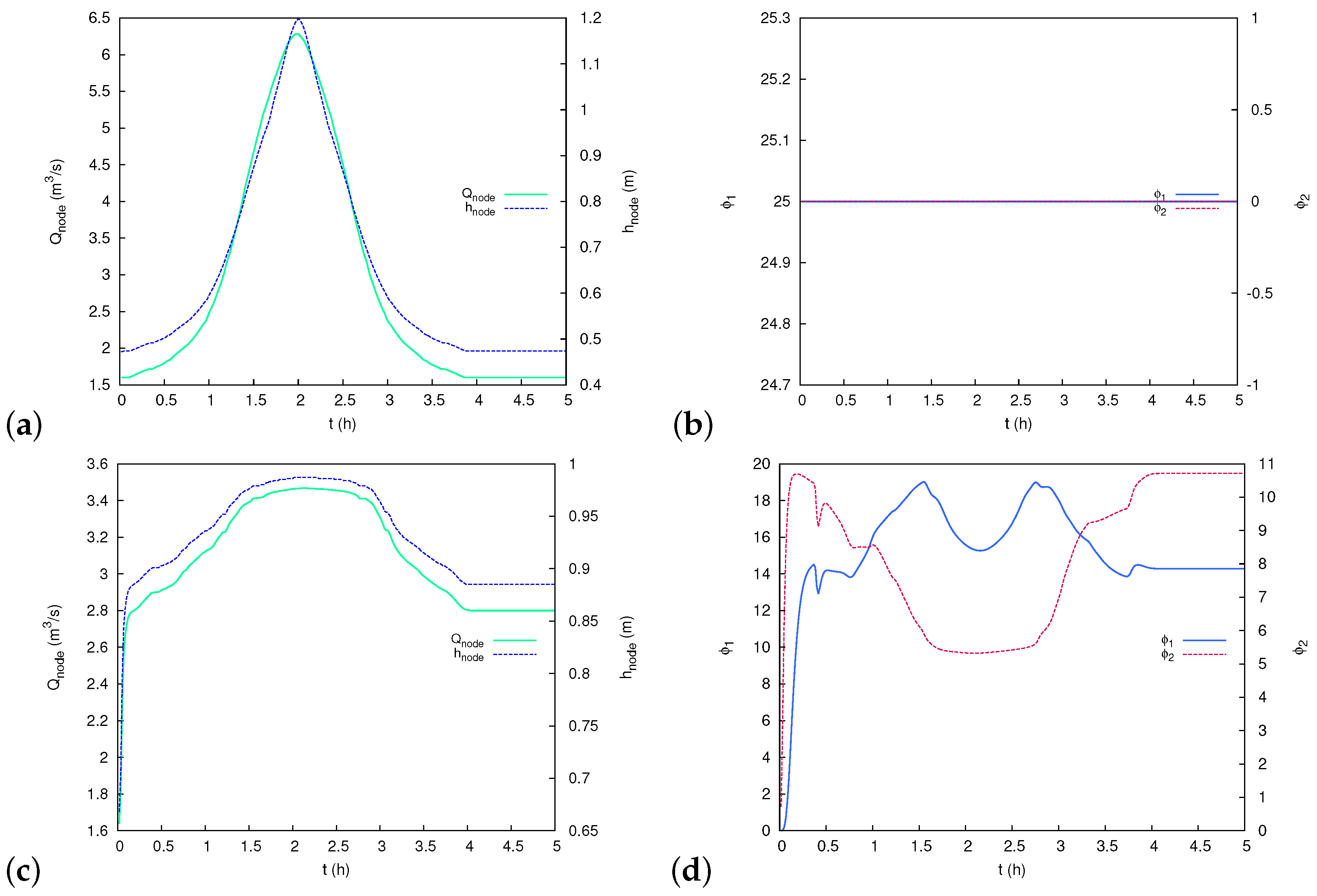
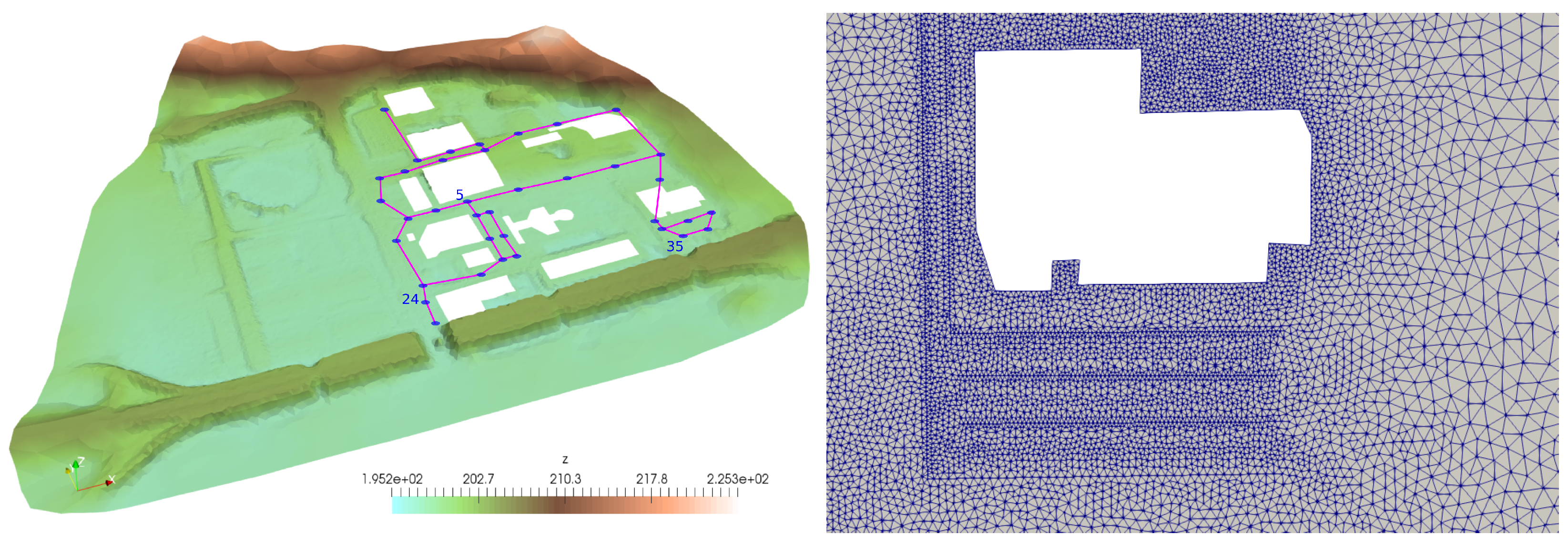
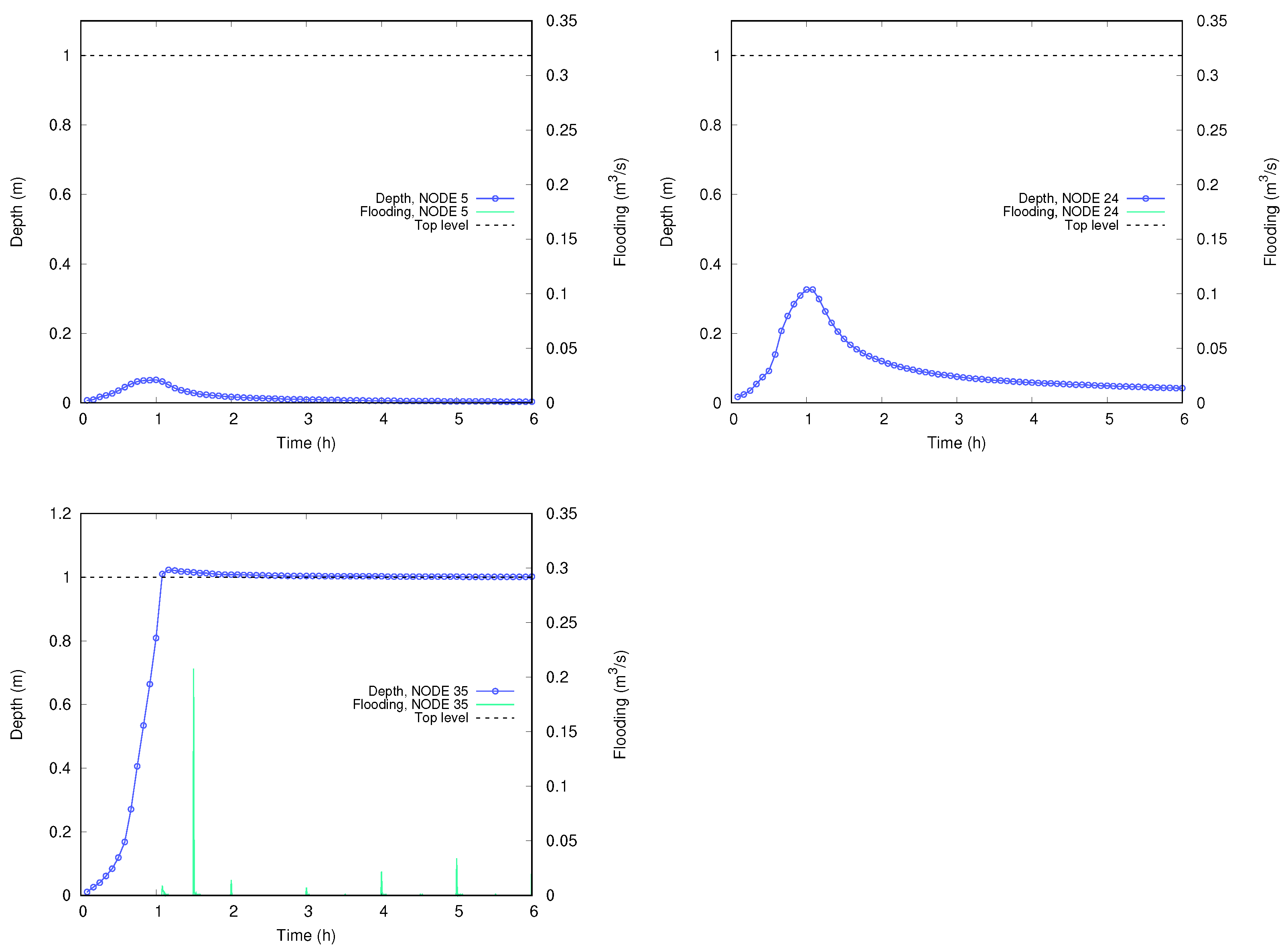
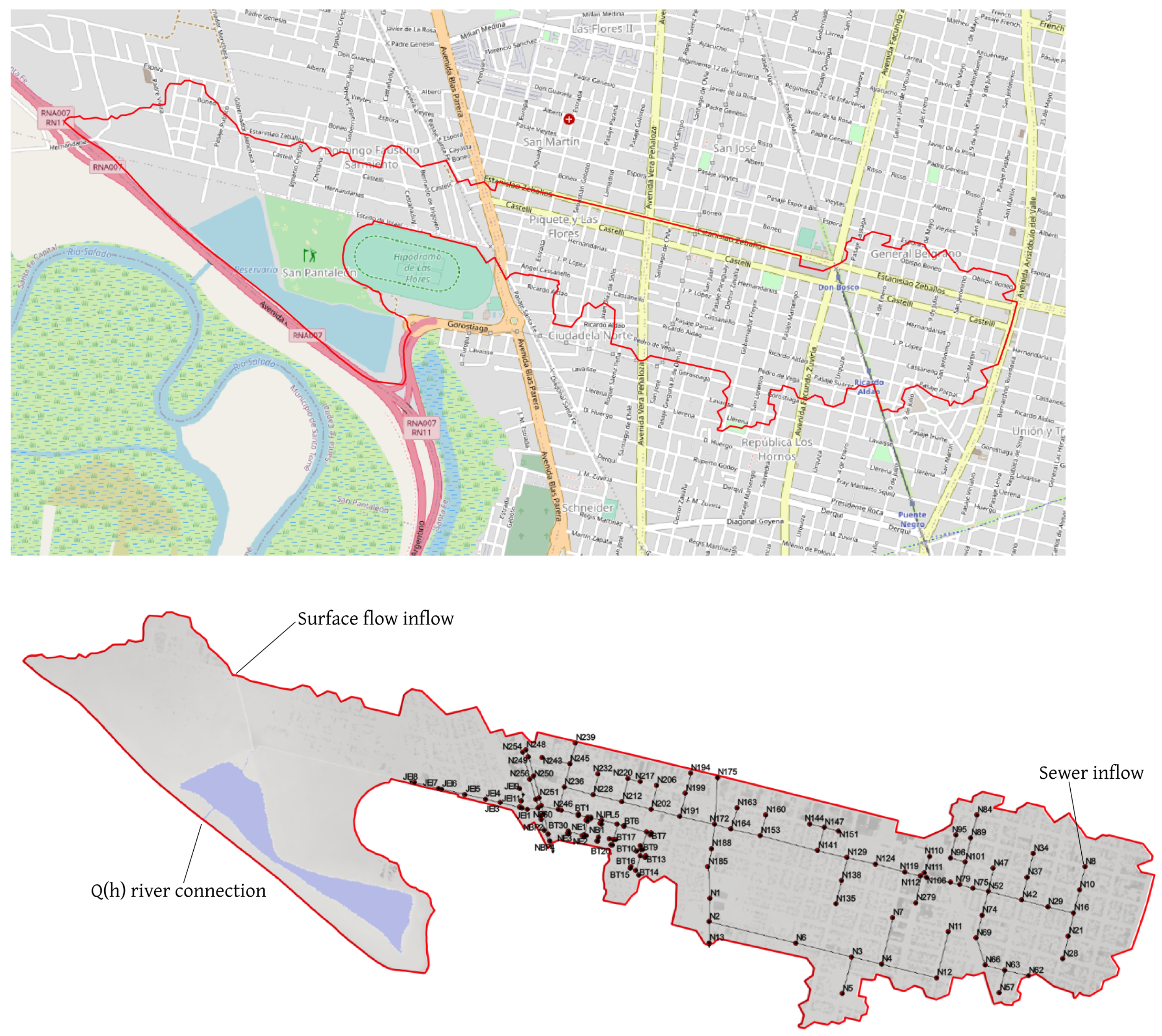

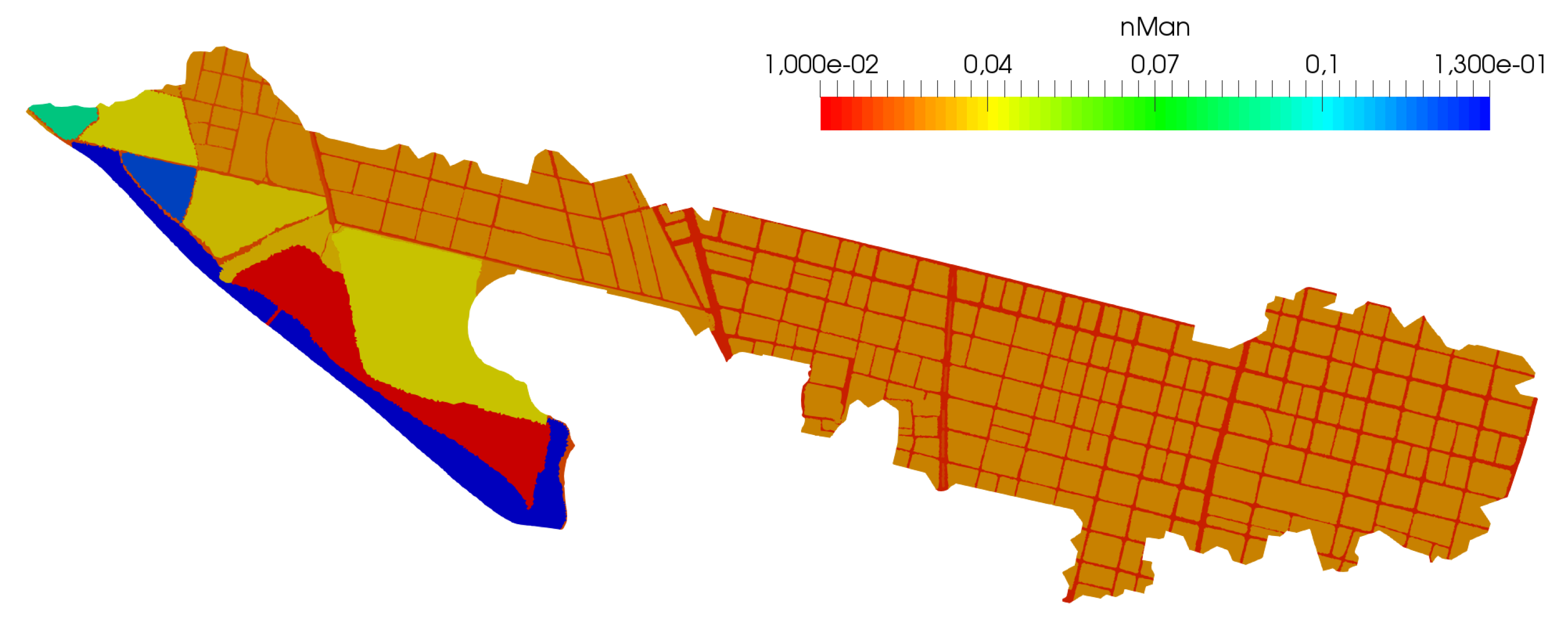
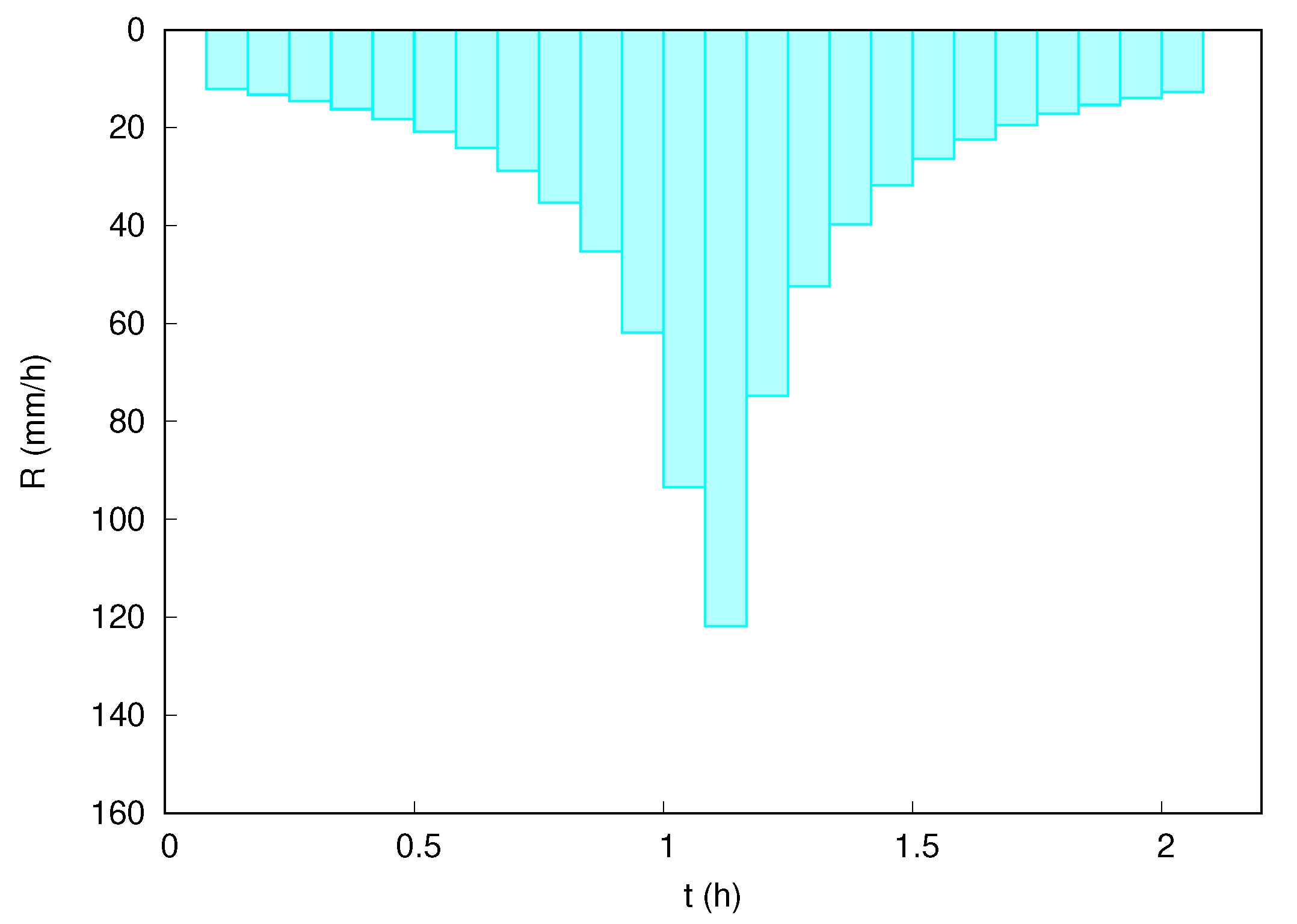
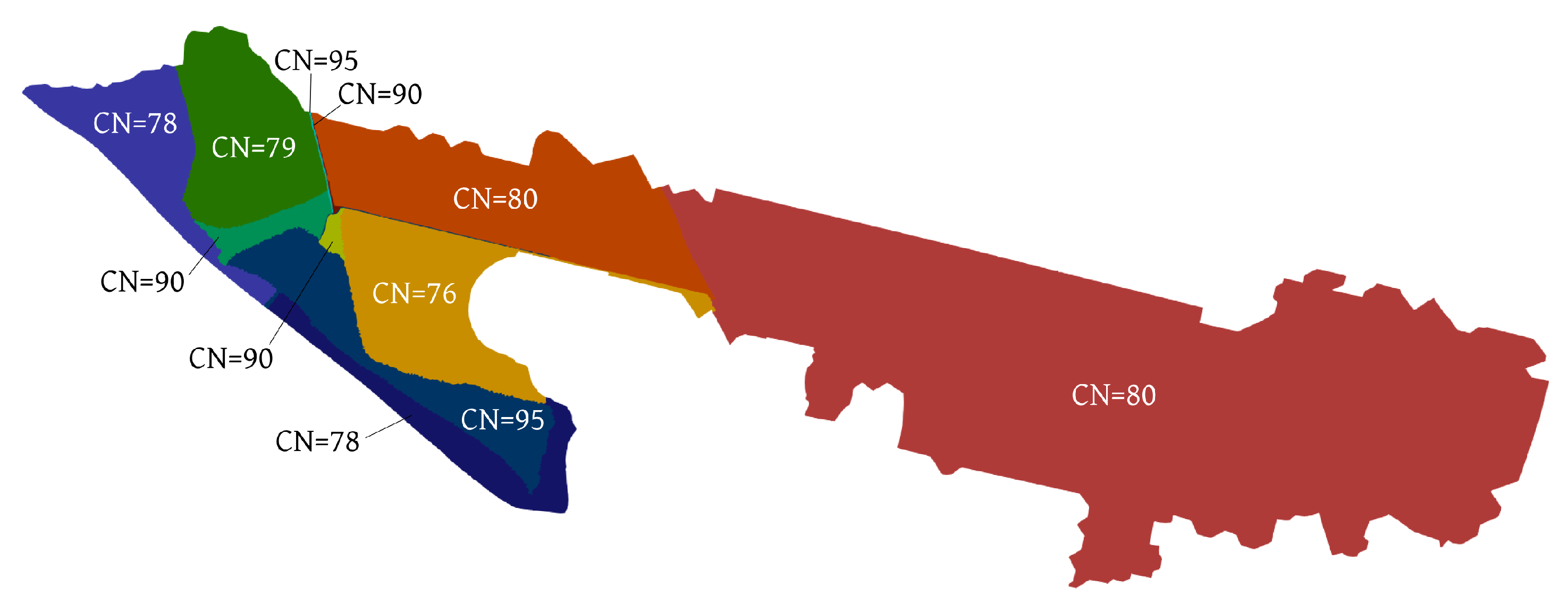
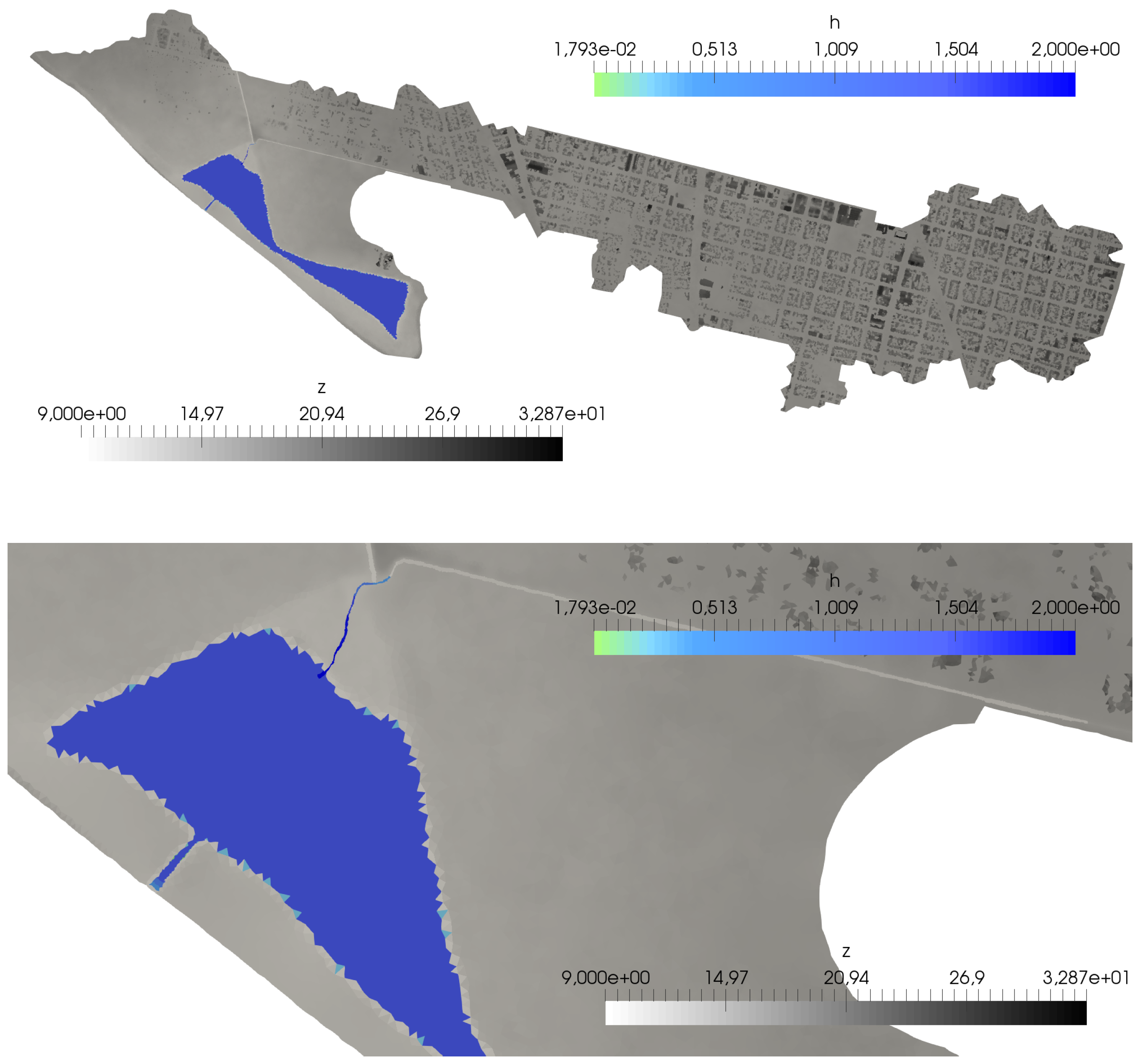
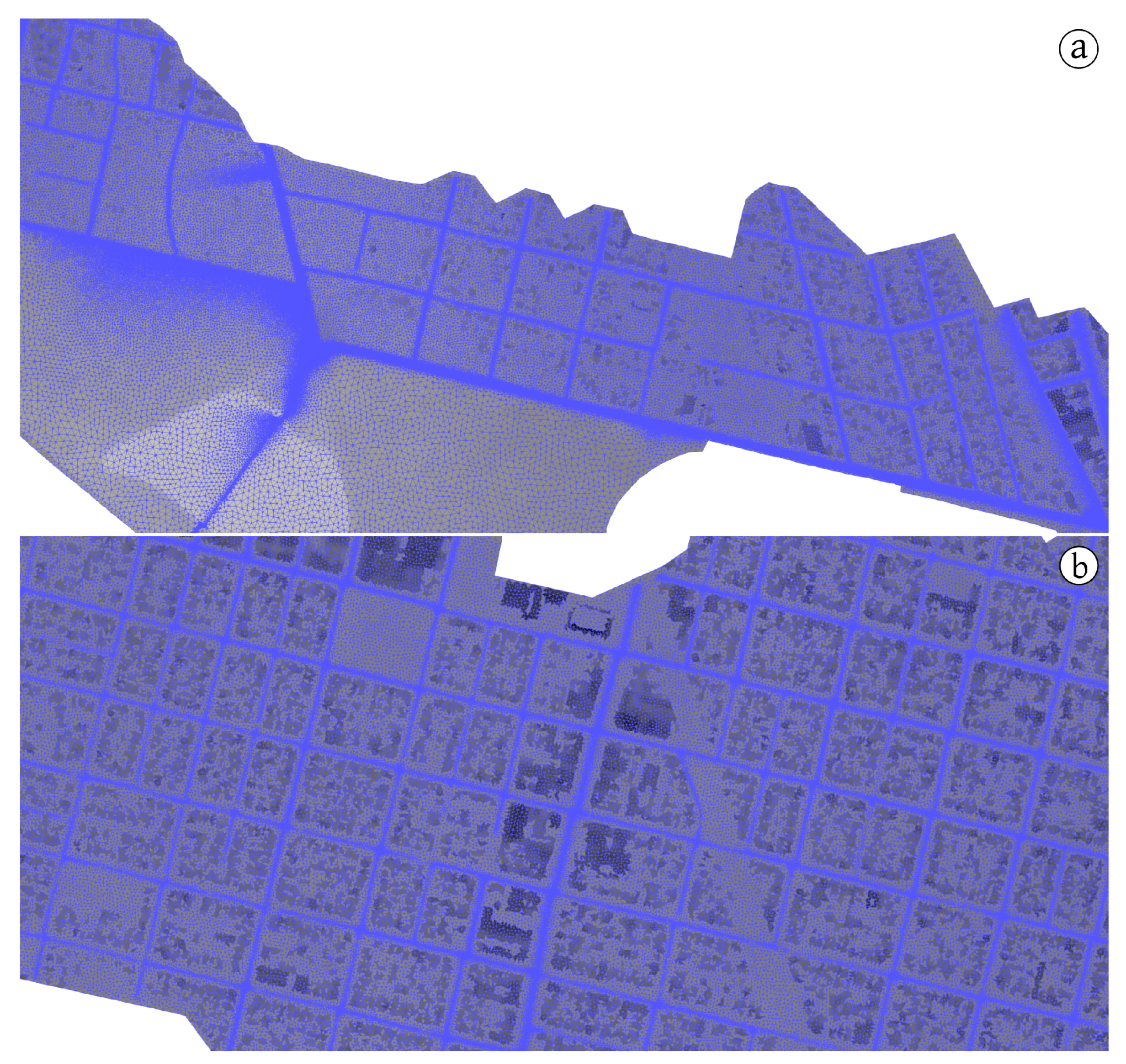
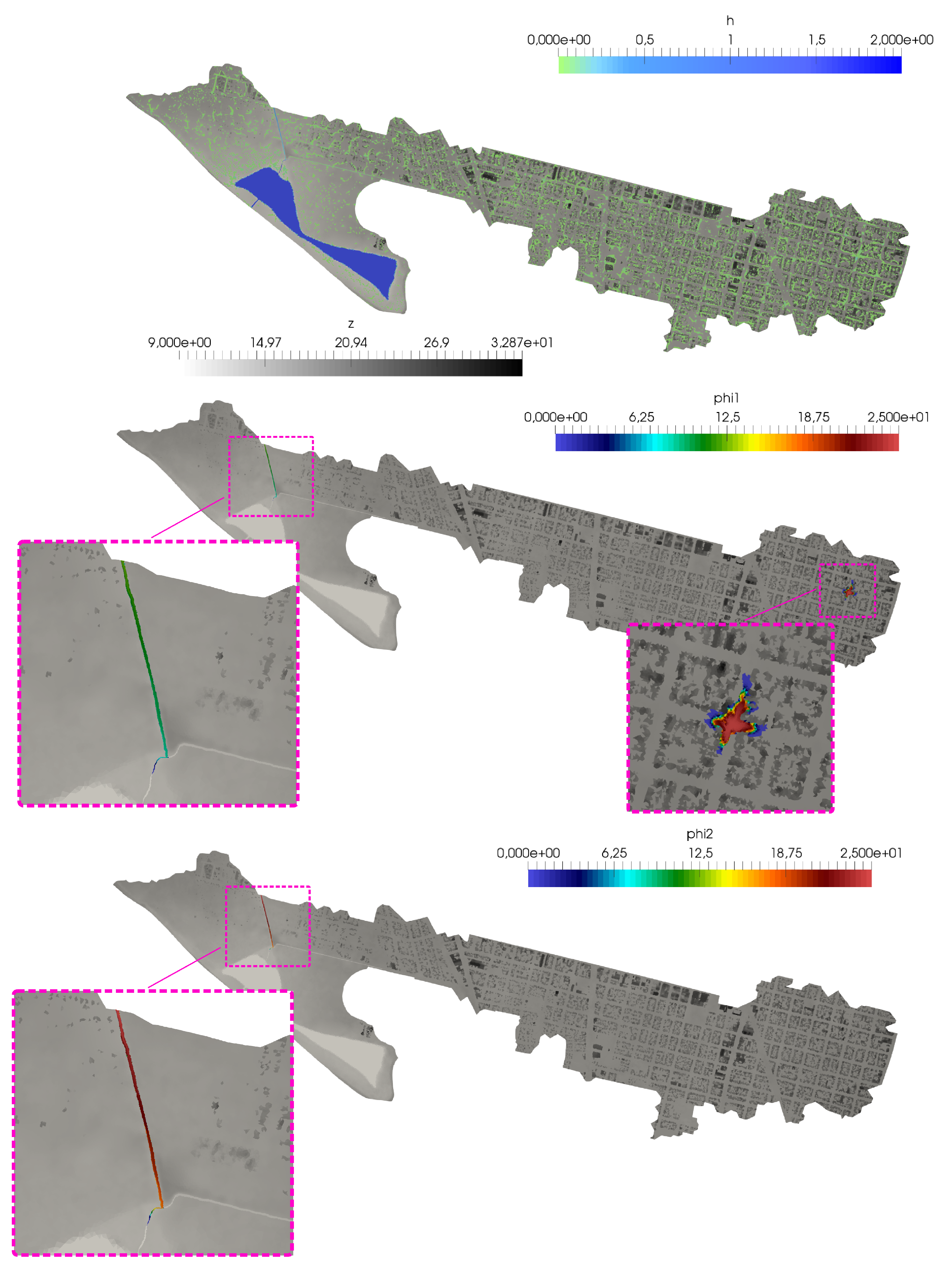
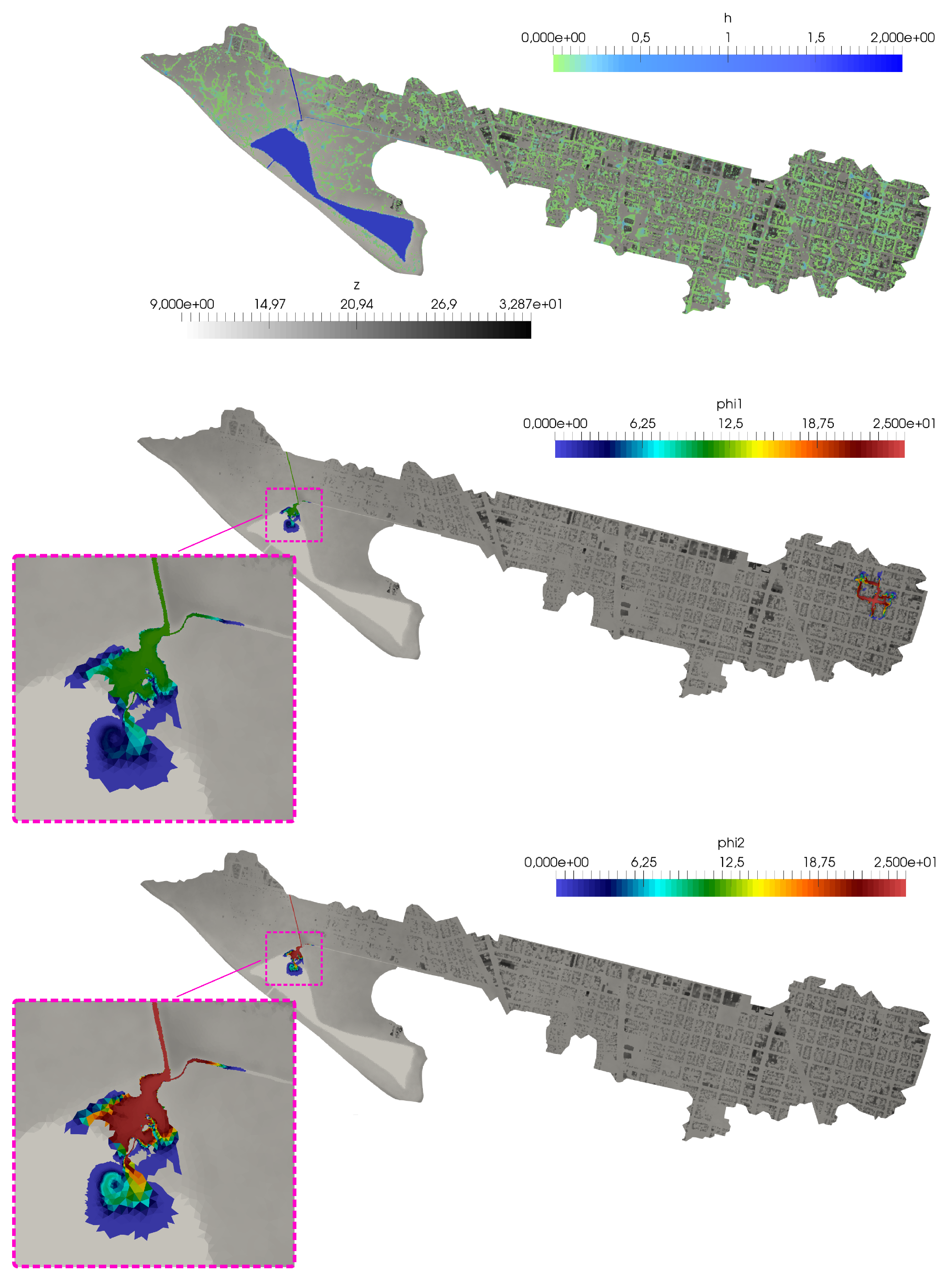
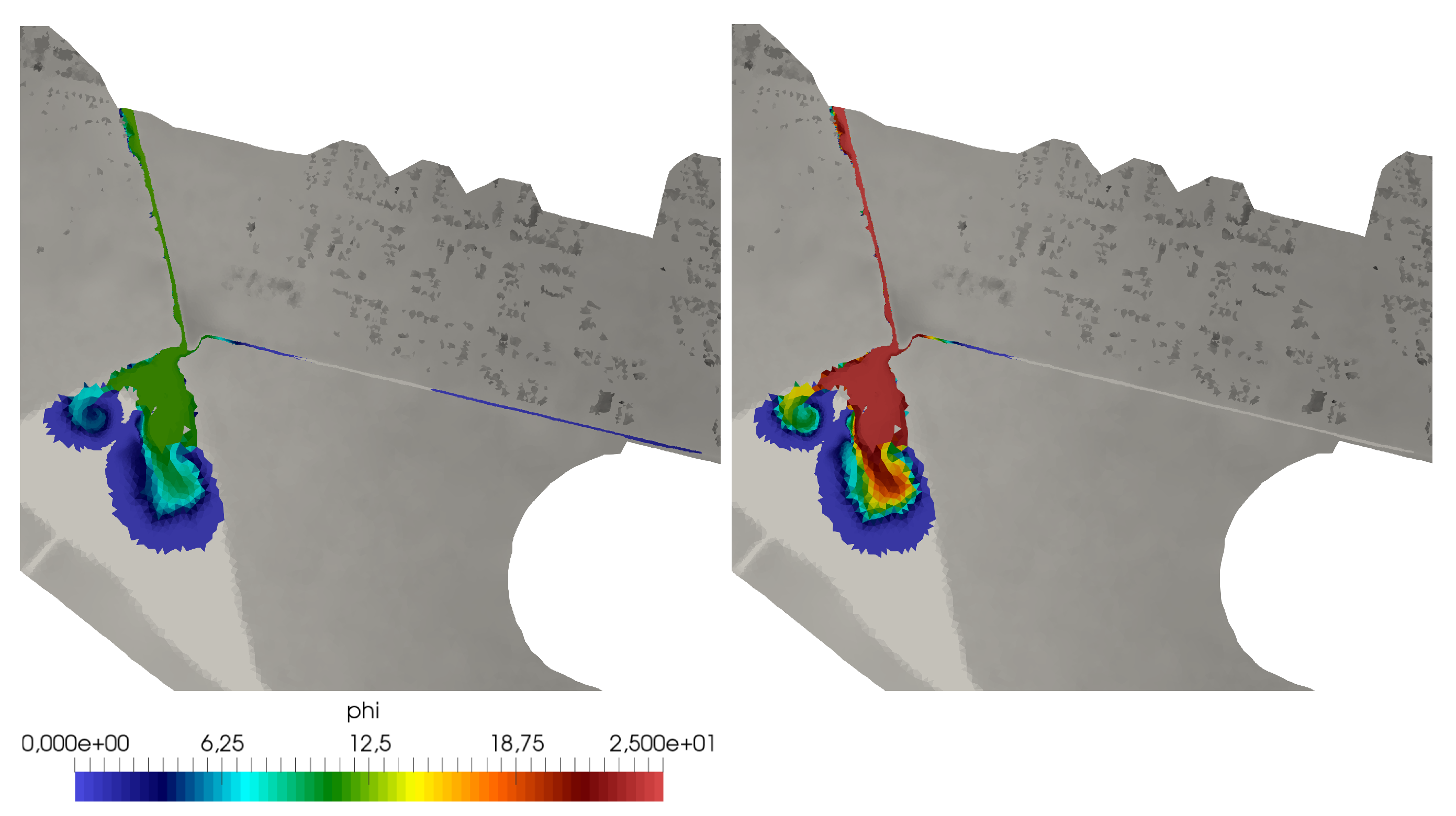
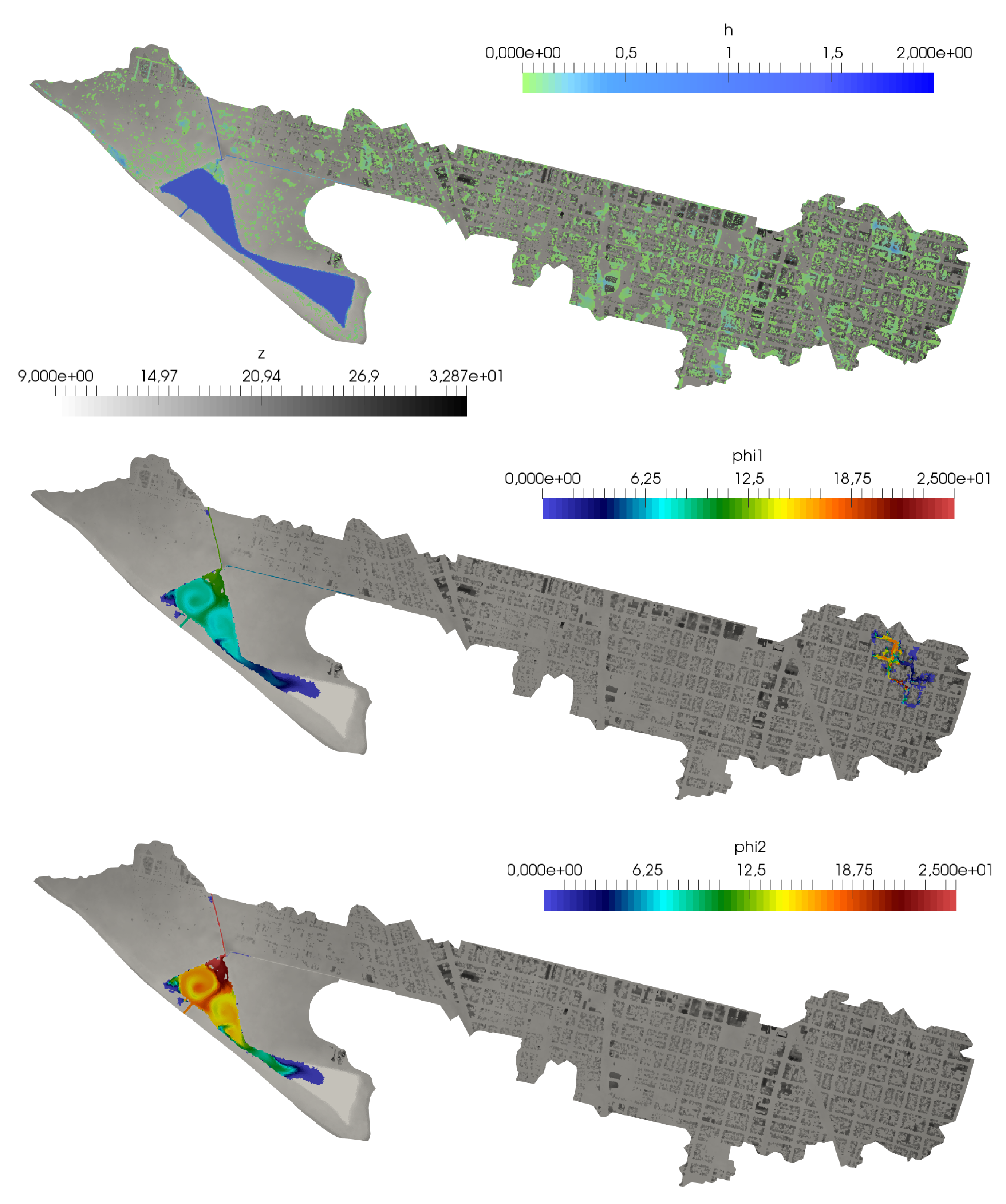
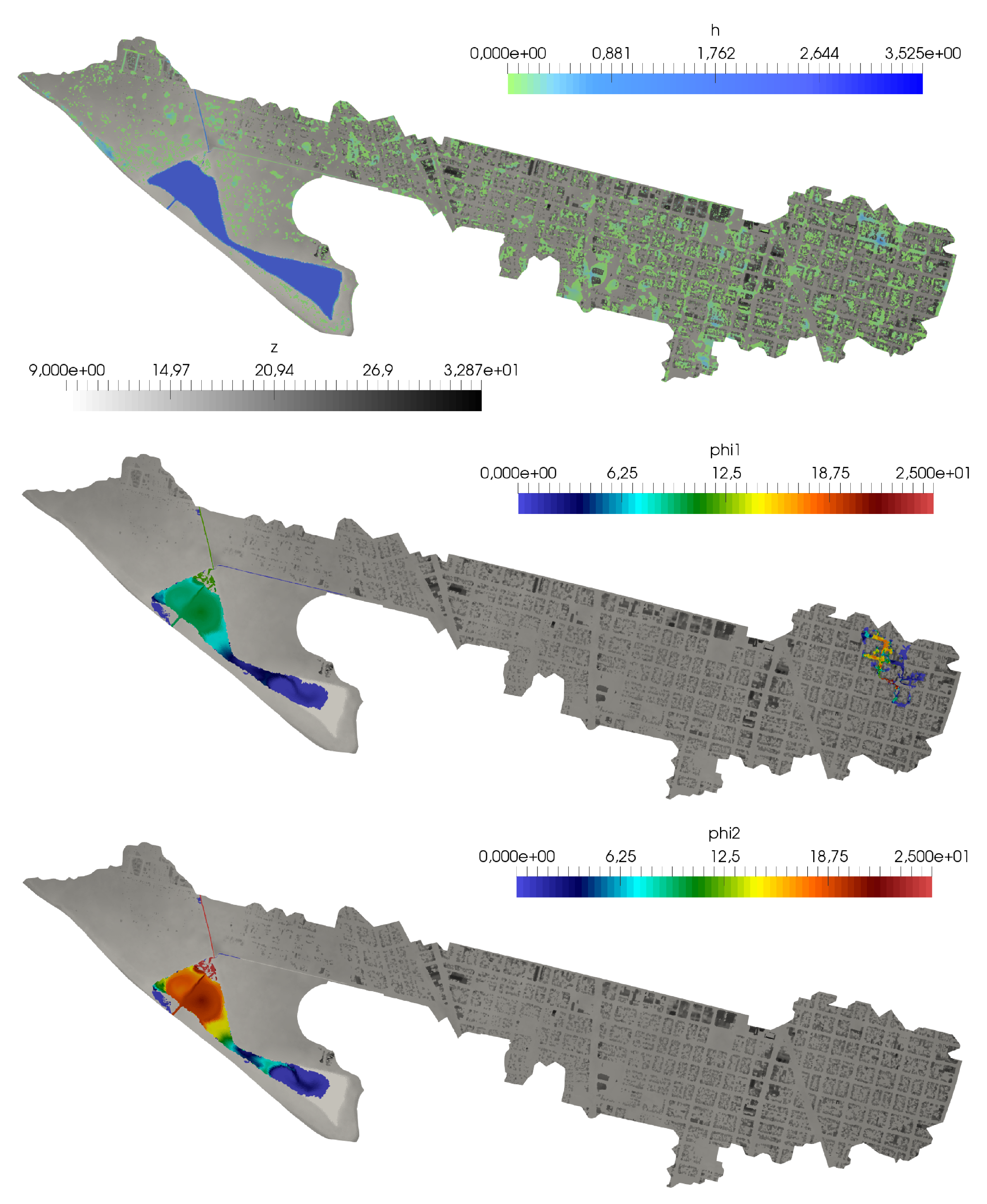
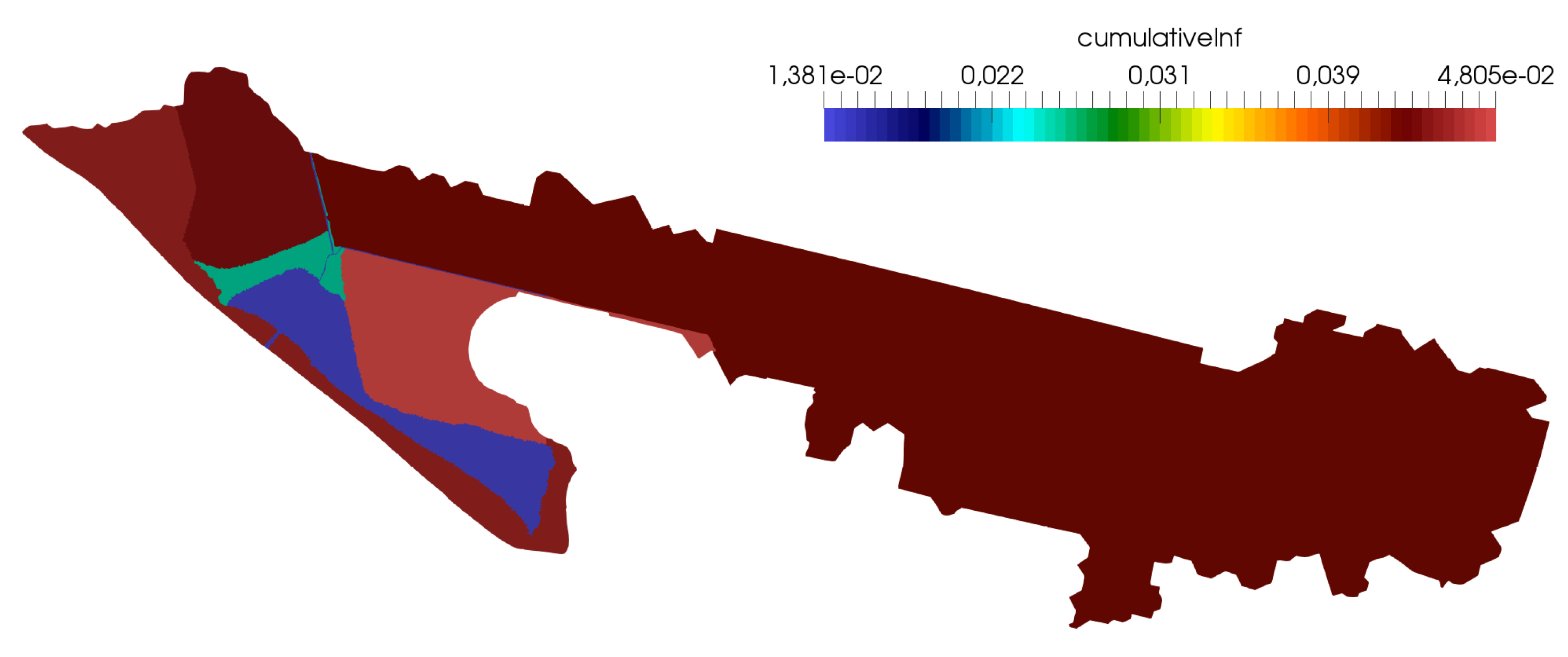
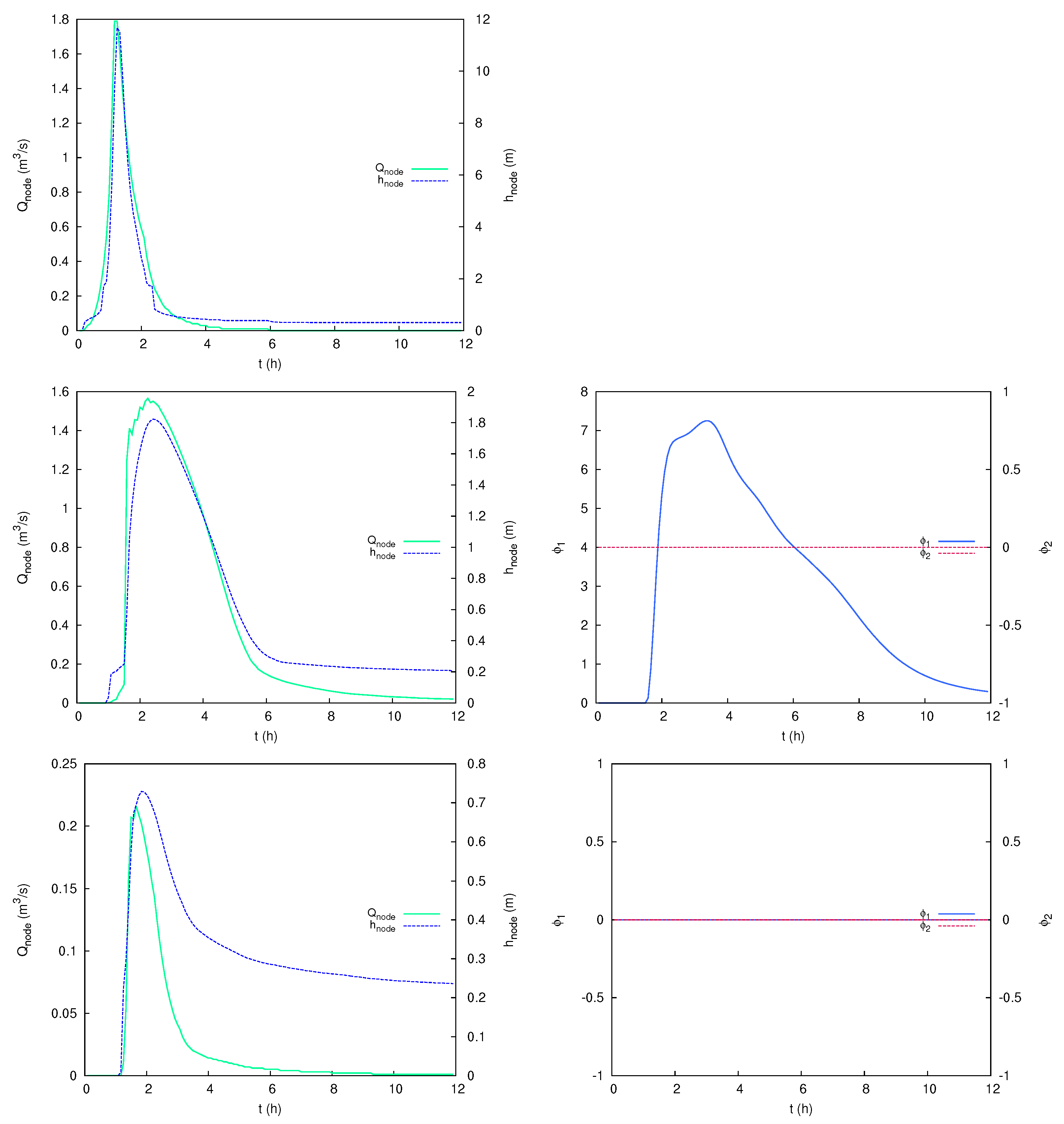
| CPU (1 Core) | CPU (6 Cores) | GPU (Tesla C2075) | GPU (Titan Black) | |
|---|---|---|---|---|
| Comp. time (h) | 30.9 | 5.43 | 0.766 | 0.264 |
| Speed-up | - | 5.7 | 40.3 | 117.1 |
| CPU (1 Core) | CPU (6 Cores) | GPU (Tesla C2075) | GPU (GTX Titan Black) | |
|---|---|---|---|---|
| Comp. time (h) | - | 135.62 | 18.05 | 5.11 |
| Speed-up | - | - | 7.5 | 26.5 |
Publisher’s Note: MDPI stays neutral with regard to jurisdictional claims in published maps and institutional affiliations. |
© 2021 by the authors. Licensee MDPI, Basel, Switzerland. This article is an open access article distributed under the terms and conditions of the Creative Commons Attribution (CC BY) license (https://creativecommons.org/licenses/by/4.0/).
Share and Cite
Fernández-Pato, J.; García-Navarro, P. An Efficient GPU Implementation of a Coupled Overland-Sewer Hydraulic Model with Pollutant Transport. Hydrology 2021, 8, 146. https://doi.org/10.3390/hydrology8040146
Fernández-Pato J, García-Navarro P. An Efficient GPU Implementation of a Coupled Overland-Sewer Hydraulic Model with Pollutant Transport. Hydrology. 2021; 8(4):146. https://doi.org/10.3390/hydrology8040146
Chicago/Turabian StyleFernández-Pato, Javier, and Pilar García-Navarro. 2021. "An Efficient GPU Implementation of a Coupled Overland-Sewer Hydraulic Model with Pollutant Transport" Hydrology 8, no. 4: 146. https://doi.org/10.3390/hydrology8040146
APA StyleFernández-Pato, J., & García-Navarro, P. (2021). An Efficient GPU Implementation of a Coupled Overland-Sewer Hydraulic Model with Pollutant Transport. Hydrology, 8(4), 146. https://doi.org/10.3390/hydrology8040146





